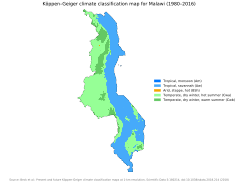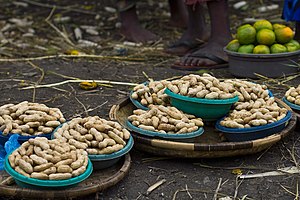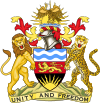
Malawi is a land-locked country in southeastern Africa situated along the southernmost arm of the East African Rift-Valley System between latitudes 9°22’ and 17°03’ south of the equator, and longitudes 33°40’ and 35°55’ east of the Greenwich meridian. It shares borders with Tanzania in the north and northeast, Mozambique in the southwest, south, and east, and Zambia in the west. Malawi is highly vulnerable to the effects of climate change as the vast majority of Malawians rely on small-scale, rain-fed agriculture, making them highly dependent on weather patterns. Climate change increasingly exacerbates droughts, flooding, and inconsistent rainfall—contributing to food insecurity and threatening to derail progress toward Malawi's goal of self-reliance.
Greenhouse Gas Emissions
Malawi emitted a total of 10.85 million metric tons of carbon dioxide equivalent (MtCO2e) in 2011, accounting for merely 0.02 percent of global greenhouse gas (GHG) emissions. The land-use change and forestry sector contributed 56 percent of Malawi's GHG emissions, followed by the agriculture, waste, and industrial processes sectors, which collectively contributed 40 percent, 2 percent, and 2 percent, respectively. Between 1990 and 2011, GHG emissions in Malawi witnessed a 14 percent increase, whereas the country's Gross Domestic Product (GDP) experienced a notable growth of 126 percent during the same time frame. However, despite the faster growth of GDP, Malawi's economy emitted approximately three times more GHGs relative to GDP compared to the global average in 2011, suggesting the potential for improvement. According to UNDP, Malawi had 0.04% Share of global GHG emissions, with 158 Climate Vulnerability Index ranking, 169 Human Development Index ranking, 51% Conditional emissions reduction target by 2040 as of July 2021.
| Year | Fossil CO2
Emissions ( tons ) |
CO2 emisions
change |
CO2 emissions
per capita |
Population | Pop .
change |
Share of World's
CO2 emissions |
| 2016 | 1,815,598 | 3.26% | 0.1 | 17,405,624 | 2.76% | 0.01% |
| 2015 | 1,758,327 | 0.15% | 0.1 | 16,938,942 | 2.80% | 0.00% |
| 2014 | 1,755,703 | 6.17% | 0.11 | 16,477,966 | 2.83% | 0.00% |
| 2013 | 1,653,643 | 3.51% | 0.1 | 16,024,775 | 2.85% | 0.00% |
| 2012 | 1,597,618 | 1.98% | 0.1 | 15,581,251 | 2.87% | 0.00% |
| 2011 | 1,566,662 | 2.30% | 0.1 | 15,146,094 | 2.91% | 0.00% |
| 2010 | 1,531,406 | 7.80% | 0.1 | 14,718,422 | 2.93% | 0.00% |
| 2009 | 1,420,539 | -0.91% | 0.1 | 14,298,932 | 2.95% | 0.00% |
| 2008 | 1,433,560 | 6.27% | 0.1 | 13,889,423 | 2.92% | 0.00% |
| 2007 | 1,348,951 | 5.73% | 0.1 | 13,495,463 | 2.88% | 0.00% |
| 2006 | 1,275,876 | 3.44% | 0.1 | 13,118,307 | 2.84% | 0.00% |
| 2005 | 1,233,487 | 3.23% | 0.1 | 12,755,648 | 2.77% | 0.00% |
| 2004 | 1,194,937 | 3.97% | 0.1 | 12,411,342 | 2.68% | 0.00% |
| 2003 | 1,149,325 | 1.77% | 0.1 | 12,087,965 | 2.58% | 0.00% |
| 2002 | 1,129,387 | 2.24% | 0.1 | 11,784,498 | 2.48% | 0.00% |
| 2001 | 1,104,693 | 5.90% | 0.1 | 11,498,818 | 2.40% | 0.00% |
| 2000 | 1,043,156 | -3.30% | 0.09 | 11,229,387 | 2.33% | 0.00% |
| 1999 | 1,078,757 | 5.87% | 0.1 | 10,973,956 | 2.25% | 0.00% |
| 1998 | 1,018,990 | -10.92% | 0.09 | 10,732,456 | 2.09% | 0.00% |
| 1997 | 1,143,953 | 18.66% | 0.11 | 10,512,678 | 1.96% | 0.00% |
| 1996 | 964,064 | -0.68% | 0.09 | 10,310,528 | 1.96% | 0.00% |
| 1995 | 970,671 | 4.91% | 0.1 | 10,112,816 | -0.19% | 0.00% |
| 1994 | 925,247 | 18.76% | 0.09 | 10,131,799 | -1.22% | 0.00% |
| 1993 | 779,070 | -0.77% | 0.08 | 10,257,233 | 1.40% | 0.00% |
| 1992 | 785,137 | -0.12% | 0.08 | 10,115,420 | 2.89% | 0.00% |
| 1991 | 786,057 | 19.29% | 0.08 | 9,831,584 | 3.06% | 0.00% |
| 1990 | 658,919 | -8.82% | 0.07 | 9,539,665 | 3.98% | 0.00% |
| 1989 | 722,640 | 6.61% | 0.08 | 9,174,895 | 4.80% | 0.00% |
| 1988 | 677,845 | -2.54% | 0.08 | 8,754,781 | 5.53% | 0.00% |
| 1987 | 695,483 | 25.12% | 0.08 | 8,295,993 | 4.88% | 0.00% |
| 1986 | 555,847 | 3.79% | 0.07 | 7,909,819 | 3.73% | 0.00% |
| 1985 | 535,545 | 6.30% | 0.07 | 7,625,078 | 3.90% | 0.00% |
| 1984 | 503,812 | -4.74% | 0.07 | 7,339,002 | 3.98% | 0.00% |
| 1983 | 528,893 | -10.57% | 0.07 | 7,058,317 | 4.04% | 0.00% |
| 1982 | 591,389 | -7.92% | 0.09 | 6,784,347 | 4.06% | 0.00% |
| 1981 | 642,266 | -3.60% | 0.1 | 6,519,891 | 4.03% | 0.00% |
| 1980 | 666,247 | -6.64% | 0.11 | 6,267,369 | 3.95% | 0.00% |
| 1979 | 713,649 | 13.63% | 0.12 | 6,029,140 | 3.79% | 0.00% |
| 1978 | 628,052 | 14.78% | 0.11 | 5,808,810 | 3.51% | 0.00% |
| 1977 | 547,192 | -0.11% | 0.1 | 5,611,712 | 3.19% | 0.00% |
| 1976 | 547,811 | -5.55% | 0.1 | 5,438,226 | 2.98% | 0.00% |
| 1975 | 580,029 | 13.90% | 0.11 | 5,280,965 | 2.86% | 0.00% |
| 1974 | 509,239 | 3.53% | 0.1 | 5,134,199 | 2.76% | 0.00% |
| 1973 | 491,868 | 3.90% | 0.1 | 4,996,239 | 2.68% | 0.00% |
| 1972 | 473,413 | 0.41% | 0.1 | 4,865,978 | 2.60% | 0.00% |
| 1971 | 471,501 | 0.54% | 0.1 | 4,742,480 | 2.54% | 0.00% |
Impact on the Natural Environment
Temperature and weather changes
 Köppen climate classification map for Malawi for 1980–2016
Köppen climate classification map for Malawi for 1980–2016 2071–2100 map under the most intense climate change scenario. Mid-range scenarios are currently considered more likely
2071–2100 map under the most intense climate change scenario. Mid-range scenarios are currently considered more likely
Malawi has encountered climate change and climate variability in recent decades, leading to a proliferation of severe climate-related shocks that have experienced an increase in frequency over the past few decades resulting in a series of devastating climate shocks that have become more frequent in recent years. These shocks include irregular rainfall, droughts, extended periods of dry weather, and powerful winds. The altering climate has had an impact on numerous sectors of the economy, including agriculture, health, water, energy, transportation, education, gender, forestry, wildlife, and infrastructure.
Malawi experiences two primary seasons: the cool, dry season, which occurs between May and October, with average temperatures of approximately 13 °C in June and July, and the hot, wet season, which takes place from November to April, with temperatures ranging from 30°- 35 °C. Precipitation levels vary depending on the altitude, with rift valley floors receiving approximately 600 mm of rainfall annually and mountainous regions experiencing around 1600 mm. Local variations in rainfall are influenced by the intricate topography, leading to the diversion of moisture-laden winds, ultimately causing precipitation and rain shadow effects in different terrains.
Impact on water resources
Weather-related shocks are becoming increasingly frequent and devastating in the country, with notable examples being the major floods of 2015 and Cyclone Idai in 2019. Malawi is currently facing heightened surface run-off due to intensified rainfall, resulting in reduced water percolation and retention in groundwater supplies and surface water bodies. Many regions in the country are already observing a decline in the water table, with some perennial rivers transitioning into seasonal ones. The southern area, in particular, exhibits distinct hotspots for weather-related shocks attributed to the decline in annual rainfall and evapotranspiration.
Impact on people

Droughts and floods, the most severe of these hazards, have exhibited an increase in frequency, intensity, and magnitude over the past two decades, consequently leading to grave implications on food and water security, water quality, energy resources, and sustainable livelihoods of rural communities. Within the period from 1979 to 2008, a total of 2,596 individuals lost their lives due to natural disasters, and nearly an additional 21.7 million people experienced adverse effects. Floods and droughts stand as the primary cause of chronic food security, which remains widespread across various regions within the country.
Economic impacts
Climate change results in increased variability in crop yields, impacting agricultural productivity - a vital sector for the economy of Malawi. The heightened risk of flooding poses a significant threat to the road infrastructure of Malawi, leading to transportation and connectivity issues. In the absence of climate-informed economic development, the World Bank cautions that climate change could potentially diminish Malawi's GDP by 3 to 9 percent by 2030, 6 to 20 percent by 2040, and 8 to 16 percent by 2050.
Agriculture and livestock
Further information: Agriculture in Malawi


Drought and heavy rains pose challenges for Malawi, disrupting conventional farming practices and posing a threat to crop yields. As a response, farming families are implementing adaptive measures to address climate change, emphasizing the importance of resilience in the agriculture sector. Both droughts and floods have the potential to devastate crops and soil, which in turn jeopardizes farmers' harvests and agricultural sustainability. The rise in temperatures contributes to increased evapotranspiration and decreased soil moisture, having a detrimental impact on maize farming and food security. Climate change projections indicate that there will be changes in the suitability of crops, which will affect both staple and cash crops in Malawi. Moreover, Malawi is witnessing a rise in the frequency and intensity of climate-related events, further exacerbating the impact on the agriculture sector. Climate change results in a reduction in the availability of feed and forage, thereby impacting the nutritional resources for livestock. The Alterations in temperature and precipitation patterns give rise to water scarcity, thereby affecting the availability of water for livestock. The Escalating temperatures contribute to heat stress in livestock, thereby impacting their health and productivity. Climate change influences the prevalence of livestock diseases, thereby presenting additional challenges to animal health. In Malawi, climate change poses a significant threat to food security, necessitating farming families to adapt their production methods to mitigate the impacts of the changing climate.
Mitigation and adaptations
In 2013, Malawi drafted a National Climate Change Policy intending to guide actions to reduce vulnerability to climate change for both humans and ecosystems. The policy focuses on adaptation and mitigation, technology transfer, and capacity building. In terms of mitigation, Malawi is committed to improving land use, implementing climate-smart agriculture, promoting renewable energy, utilizing the Clean Development Mechanism and voluntary carbon markets, as well as implementing REDD+.
See also
- Climate change in Africa
- Effects of climate change on agriculture
- Climate change adaptation
- Agriculture in Malawi
- Geography of Malawi
- Health in Malawi
- Climate change in Tanzania
- Climate change in Zambia
- Climate change in Mozambique
- Climate Change in Eritrea
- Climate change in Uganda
References
- ^ "World Bank Climate Change Knowledge Portal". climateknowledgeportal.worldbank.org. Retrieved 2023-12-22.
- ^ "Malawi Climate Change Country Profile | Climate". U.S. Agency for International Development. 2023-11-28. Retrieved 2023-12-22.
- ^ "Greenhouse Gas Emissions Factsheet: Malawi". www.climatelinks.org. 2016-12-31. Retrieved 2023-12-22.
- "Malawi". UNDP Climate Promise. Retrieved 2023-12-22.
- "Malawi CO2 Emissions - Worldometer". www.worldometers.info. Retrieved 2023-12-22.
- Hausfather, Zeke; Peters, Glen (29 January 2020). "Emissions – the 'business as usual' story is misleading". Nature. 577 (7792): 618–20. Bibcode:2020Natur.577..618H. doi:10.1038/d41586-020-00177-3. PMID 31996825.
- Schuur, Edward A.G.; Abbott, Benjamin W.; Commane, Roisin; Ernakovich, Jessica; Euskirchen, Eugenie; Hugelius, Gustaf; Grosse, Guido; Jones, Miriam; Koven, Charlie; Leshyk, Victor; Lawrence, David; Loranty, Michael M.; Mauritz, Marguerite; Olefeldt, David; Natali, Susan; Rodenhizer, Heidi; Salmon, Verity; Schädel, Christina; Strauss, Jens; Treat, Claire; Turetsky, Merritt (2022). "Permafrost and Climate Change: Carbon Cycle Feedbacks From the Warming Arctic". Annual Review of Environment and Resources. 47: 343–371. doi:10.1146/annurev-environ-012220-011847.
Medium-range estimates of Arctic carbon emissions could result from moderate climate emission mitigation policies that keep global warming below 3°C (e.g., RCP4.5). This global warming level most closely matches country emissions reduction pledges made for the Paris Climate Agreement...
- Phiddian, Ellen (5 April 2022). "Explainer: IPCC Scenarios". Cosmos. Archived from the original on 20 September 2023. Retrieved 30 September 2023.
"The IPCC doesn't make projections about which of these scenarios is more likely, but other researchers and modellers can. The Australian Academy of Science, for instance, released a report last year stating that our current emissions trajectory had us headed for a 3°C warmer world, roughly in line with the middle scenario. Climate Action Tracker predicts 2.5 to 2.9°C of warming based on current policies and action, with pledges and government agreements taking this to 2.1°C.
- "MALAWI CLIMATE CHANGE FACT SHEET | Fact Sheet | Malawi | Archive - U.S. Agency for International Development". 2017-2020.usaid.gov. 2016-09-26. Retrieved 2023-12-22.
- Global Water, Partnerships; UNICEF (2022). "Malawi snapshot on water and climate" (PDF). Global Water Partnerships.
- "From climate risk to resilience: Unpacking the economic impacts of climate change in Malawi". www.ifpri.org. Retrieved 2023-12-22.
- "From Climate Risk to Resilience: Unpacking the Economic Impacts of Climate Change in Malawi, November 2023 - Malawi | ReliefWeb". reliefweb.int. 2023-11-10. Retrieved 2023-12-22.
- "Climate-Informed Economic Development Key to Malawi's Future Growth and Resilience". World Bank. Retrieved 2023-12-22.
- ^ "Feeding people and protecting forests: agriculture in a changing climate - Malawi | ReliefWeb". reliefweb.int. 2023-05-22. Retrieved 2023-12-22.
- Kelly, Emma (2023-05-04). "Malawi: Fighting the ravages of climate change with smart agriculture". Concern Worldwide. Retrieved 2023-12-22.
- Stevens, Tilele; Madani, Kaveh (2016-11-08). "Future climate impacts on maize farming and food security in Malawi". Scientific Reports. 6 (1): 36241. Bibcode:2016NatSR...636241S. doi:10.1038/srep36241. ISSN 2045-2322. PMC 5099946. PMID 27824092.
- "What are the potential impacts of climate change on the agriculture sector in Malawi, and how can agribusinesses respond?". iBAN. Retrieved 2023-12-22.
- ^ Rahut, Dil Bahadur; Ali, Akhter (2018-10-01). "Impact of climate-change risk-coping strategies on livestock productivity and household welfare: empirical evidence from Pakistan". Heliyon. 4 (10): e00797. Bibcode:2018Heliy...400797R. doi:10.1016/j.heliyon.2018.e00797. ISSN 2405-8440. PMC 6197305. PMID 30364587.
| Climate change by country | |
|---|---|
| Greenhouse gas emissions, impacts, mitigation and adaptation in each country | |
| Africa | |
| Americas | |
| Asia | |
| Europe | |
| Oceania | |
| Polar regions | |
| Other regions | |
| Malawi articles | |||
|---|---|---|---|
| History |  | ||
| Geography | |||
| Politics | |||
| Economy | |||
| Society | |||